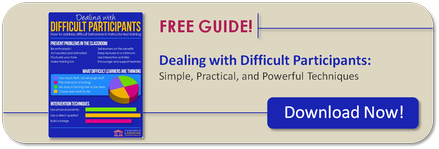As a new facilitator, you’re stepping into a crucial role where you can significantly impact the learning and development of your colleagues. One of the biggest challenges you’ll face is keeping your learners engaged and actively participating. Engagement is key to effective learning and it’s essential to create an environment where participants are motivated, attentive, and active.
Here are eight tips to help increase participation and involvement from your LEARNERS:
1. The Less you dominate, the more your learners will participate.
Create an inclusive learning environment. This is crucial for fostering engagement. Facilitate discussions instead of lecturing. Ask open-ended questions, promote peer-to-peer dialogue, and guide the conversations rather than monopolize them.
2. Incorporate small group Exercises
Get learners practicing their new knowledge and skills as early and often as possible. Small group activities create opportunities for hands-on practice, collaboration, and role-playing relevant scenarios. These exercises will help learners apply concepts and learn from each other.
3. Ask Learners to have discussions in pairs.
Have learners engage in a brief discussion with a neighbor. Ask them to formulate questions, think of examples, react to statements, or create rebuttals. Collaborative exercises like these can be followed by a debrief where teams share their thoughts or build on what previous teams have shared.
4. Use verbal and non-verbal Reinforcement.
Monitor the learners’ progress and provide feedback during practice activities. Use verbal encouragements like “You’re on the right track!” or “Great start, Team 2!” Non-verbal cues like smiling, giving a thumbs up, or even nodding also signal progress and boost morale.
5. Never tell learners what they can tell you.
Promote a collaborative environment that encourages teamwork and peer learning. Assign tasks that require collaboration and collective problem-solving. Foster an environment where learners feel comfortable sharing ideas and learning from each other.
6. Encourage learner contributions.
Invite learners to share their opinions, experiences, and insights regularly. Recognize and value the knowledge and experiences they bring to the session. Use minimal encouragements such as “uh-huh,” good,” or “right,” along with nods and smiles, to show you value their input.
7. Incorporate content Reviews.
Integrate content reviews throughout the training course. Good times for reviews include the beginning or end of a day, after a complex topic, or before and after lunch breaks. One simple and effective method is to ask questions that draw out key takeaways and how learners plan to apply their new skills back at work.
8. Remove the Spotlight from yourself.
Sit down or lean against a table to shift attention away from yourself. Use a stool to help you feel more comfortable. This subtle non-verbal cue signals to learners that it’s their turn to speak and share, encouraging more participation.
Integrating these tips will motivate your learners to become more involved and increase their participation, creating an atmosphere that promotes retention and transfer of skills back to work. These strategies will help you overcome some of the challenges you’ll face in engaging your learners.
To learn more about promoting learner participation, establishing a good climate for learning, and many other tips, sign up for Langevin’s Instructional Techniques for New Instructors workshop!
This article was first published August 30, 2021.


